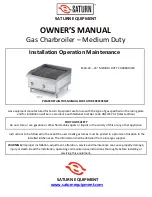
Page 107
HTD
SECTION 11 Maintenance
a. The units controls
b. Automatic gas valve
c. Air filter
d. Pressure switches
e. Blower
f. Pump
g. Flow switch
h. Low water cutoff
i. Burner
j. Heat exchanger
k. Ignitor
Do the following once every six (6) months:
1. If a strainer is employed in a pressure reducing
valve or the piping, clean it every six months.
11.A System Maintenance
Do the following once a year:
1. Lubricate all the pumps in the system, per the
instructions on the pump.
2. Inspect the venting system for obstruction or
leakage. Periodically clean the screens in the vent
terminal and combustion air terminal (when used).
3. Remove and inspect the air filter. Clean with soapy
water if needed. Be sure that filter is dry before re-
inserting back into air filter box. Replace air filter if
damaged.
4. Keep the area around the unit clear and free
of combustible materials, gasoline, or other
flammable vapors or liquids.
5. If the unit is not going to be used for extended
periods in locations where freezing normally
occurs, it should be isolated from the system and
completely drained of all water.
6. Low water cutoffs should be cleaned and inspected
annually.
7. Inspect and clean the condensate collection, float
switch and disposal system yearly.
8. Ensure that the condensate is being neutralized
properly.
9. Inspect the flue passages and clean them using
brushes or vacuums, if necessary. Sooting in
flue passages indicates improper combustion.
Determine the cause of the problem and correct it.
10. Inspect the vent system and air intake system
and ensure that all joints are sealed properly. If
any joints need to be resealed, follow venting
manufacturer’s instructions to clean and reseal
vent system.
11. The pressure relief valve should be inspected and
tested every year.
12. Once a year, the items listed below should be
inspected by a qualified service technician:
11.B Maintenance Notes
Use only genuine manufacturers replacement parts.
CAUTION
When servicing the controls, label all wires before
disconnecting them. Wiring errors can cause improper
and dangerous operation. Verify proper operation
after servicing.
WARNING
Disconnect all power to the unit before attempting any
service procedures. Contact with electricity can result
in severe injury or death.
The gas and electric controls are engineered for long
life and dependable operation, but the safety of the
equipment depends on their proper functioning.
11.B.1 Burner
Check the burner for debris. Remove the blower
assembly to access the blower adapter plate. Remove
the 4 bolts connecting the blower to the arm. Remove
the blower adapter plate to access the burner. Pull the
burner up and out. Clean the burner, if necessary, by
blowing compressed air from the outside of the burner
into the center of the burner, and wipe the inside of
the burner clean with glass cleaner. A dirty burner
may be an indication of improper combustion or dirty
combustion air. Determine the cause of the problem and
correct it. If the burner gaskets are damaged, replace
them when replacing the burner.
11.B.2 Modulating Gas Valve / Venturi
The modulating gas valve consists of a valve body that
incorporates the On/Off gas flow control and a negative
pressure regulator. It provides the air/gas ratio control
in combination with the fuel/air mixer to the unit. It is
designed to operate with gas supply pressure between
4 and 13 inches w.c.
To remove the gas valve or fuel/air mixer, shut off the
power supply to the boiler. Turn off all manual gas
valves connecting the boiler to the main gas supply line.
Remove the front doors of the boiler and the top panels
to gain access to the gas valve and fuel/air mixer.
Disconnect the four (4) flange bolts connecting the gas
manifold pipe to the gas valve. Remove the electrical
connections to the gas valve. Remove the bolts
connecting the fuel/air mixer flange to the blower. This
allows the entire gas valve and fuel/air mixer assembly
to be removed as an assembly to facilitate inspection
and cleaning.
















































